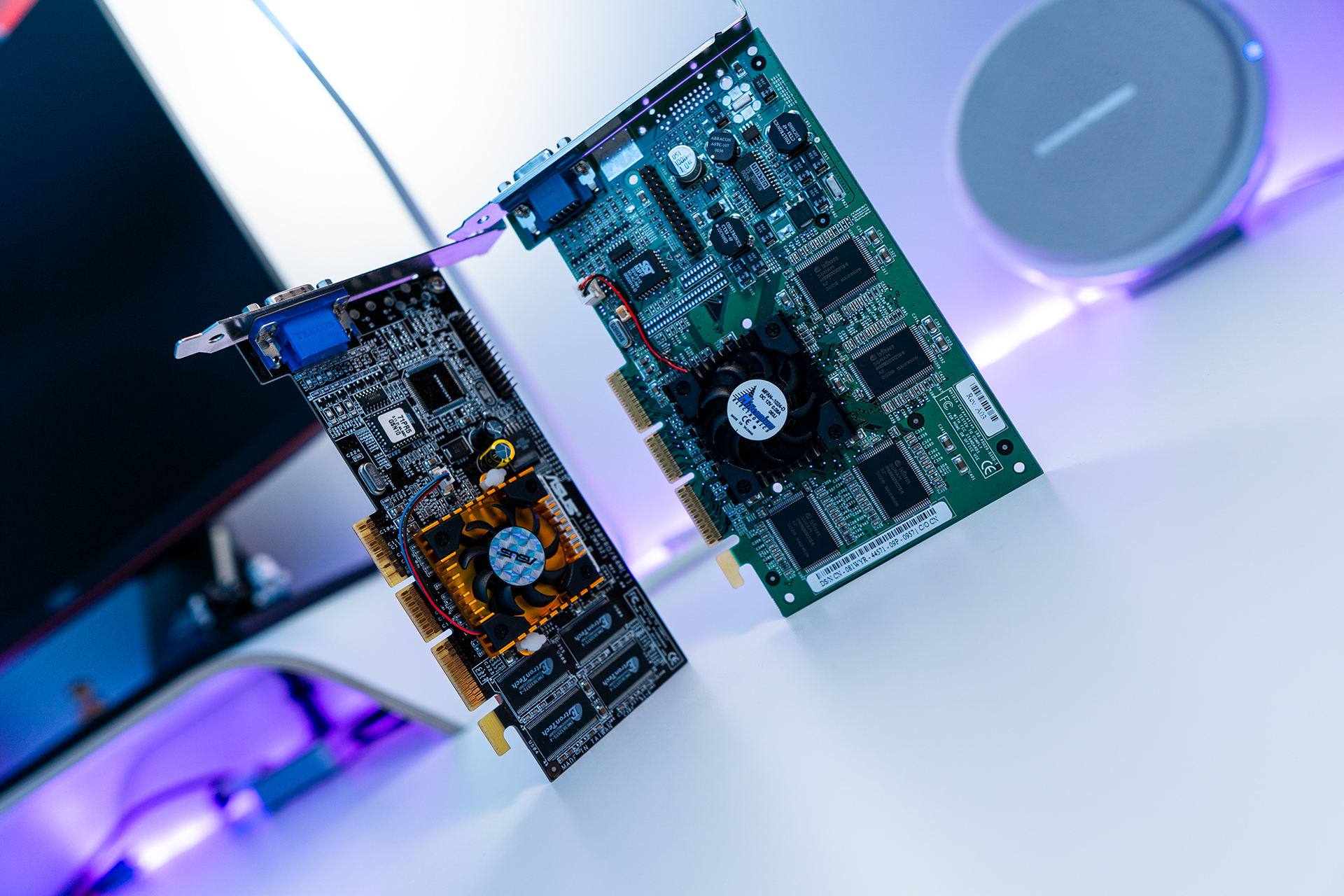
David and Goliath
In 2001 the Italian website “nv Italia” published a very interesting review: in the attempt to reach the more powerful GeForce2 GTS (but at much lower price point), a rather special GeForce2 MX400 and a Kyro II (Hercules 3D Prophet 4500) were competing against it.
But wait, how do these cards were supposed to compete with the GTS?
Well, I’m glad I asked: the Kyro II had it’s very promising tile based rendering technology, able to boost performance even at low clocks and lower specs but the ASUS V7100Pro MX400, although was basically a GTS with half of the rendering pipelines and half of the memory bandwidth had a secret weapon, very useful for the heavily bandwidth limited Celsius architecture: It had extremely-low-latency (underclocked) memory modules!
A normal MX400 comes with 64MB of RAM clocked at 166MHz and usually uses 6ns chips, rated exactly at 166MHz. Some models have slightly faster 5.5ns modules, but the V7100PRO uses 4ns EtronTech modules, rated at 250MHz (!) and this has huge potential for performance increase in the aforementioned scenario.
The ASUS V7100PRO
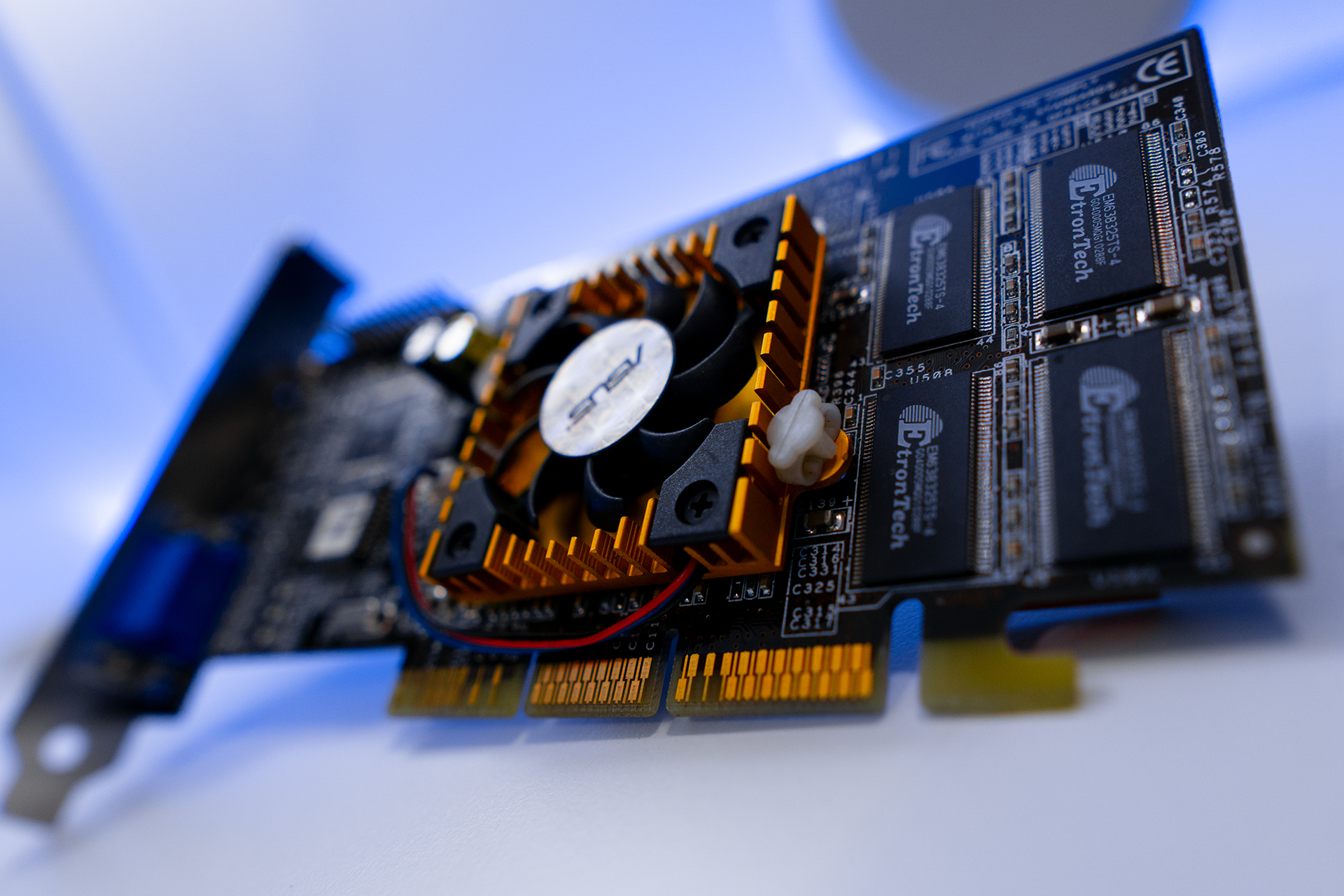
I bought this card many years ago for the sole purpose to re-propose this battle one day and that day is today, which also happens to be almost the 20th anniversary day of the GeForce2 MX400 (launched precisely on March 3rd) so what’s better than overclocking it till death (OK, not quite) for celebrating!
And yes, here is where enthusiasm meets physics reality and we must somehow reconsider our overclocking expectations.
For those familiar with old hardware, having video cards that are no longer able to maintain the original clocks is no news, especially for top of the line models which had to push to the limit the technology available at the time in order to beat/reach the competition.
So this last 20 years had some effects on our otherwise fantastic 4ns memory modules which eventually were able to maintain stable operation at no more than 223MHz, so I settle them at 220MHz for the benchmarks.
To be completely fair, since I bought this card used some years ago, I don’t know the precise frequency the RAM were able to sustain when new, and although I find it unlikely, it’s also possible that ASUS used modules that were unable to run at rated speed or something like that.
Also please note that the card has the default memory frequency at 183MHz instead of normal 166MHz, so is slightly factory overclocked and this is giving a little boost to keep in mind for the results at default.
Different story for the GPU which showed no interest for physics and time degradation and was able to maintain 250MHz with no problems; I probably would have been able to squeeze a little more, since the limit was around 260MHz, but considering the huge bottleneck caused by memory bandwidth, I decided it was not worth.
Test specs
I was very undecided on which hardware use, from one side I prefer reproduce realistic conditions that were possible at the time the hardware was released, but this would have lead to a potentially CPU limited situations and also prevented future comparison with more powerful video cards, so I decided to use a Pentium 4 Prescott based system which is plenty up to GeForce4 Ti / Radeon 9700 generation (at least).
Here are the full system specs
- ASUS P4C800
- Pentium 4 HT 3.0GHz @3.46GHz
- 2x512MB 1:1 @DDR431 - CL2.5
- Windows XP sp3 (clean install)
- ForceWare 56.72
As for the benchmarks, here is what I used
- 3DMark 2001 SE (default)
- Quake III Arena v1.17 – demo001 – Fast/High Quality preset
- Unreal Tournament v436 – City Intro - High
- Serious Sam: The First Encounter v1.05 – Karnak Peaceful Night – Normal preset
Benchmarks
3DMakrk 2001 need no presentation, it’s one of the most famouse benchmarks from the period.
It’s also interesting to know that the “Lobby” tests are based on the engine used for the game Max Payne, so with some grain of salt they can represent the performance of the game.
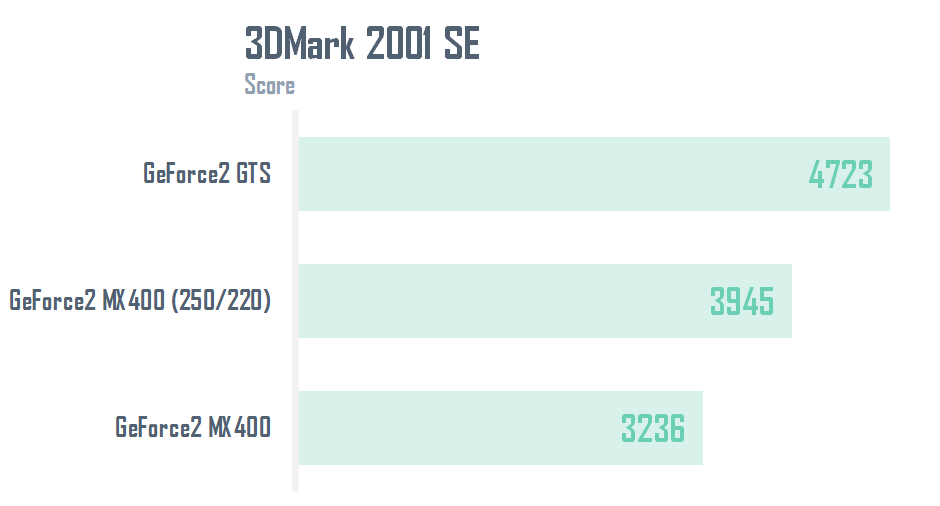
Here we can see immediately one thing that will be, with some variations, somehow recursive in all the tests: although having exactly double the fill rate of the MX400, most likely due to bandwidth limits, the GTS is not able to express it’s full potential and beat it by 100%, being able to be faster only by 46%.
To be precise, since the ASUS V7100PRO has slightly overclocked memory (at 183MHz), when clocked at 166MHz it’s scoring around 2950 points and this gives the GTS a good 60% margin.
The overclocked MX400 instead is getting pretty close to the bigger brother, closing the gap to less than 20%!
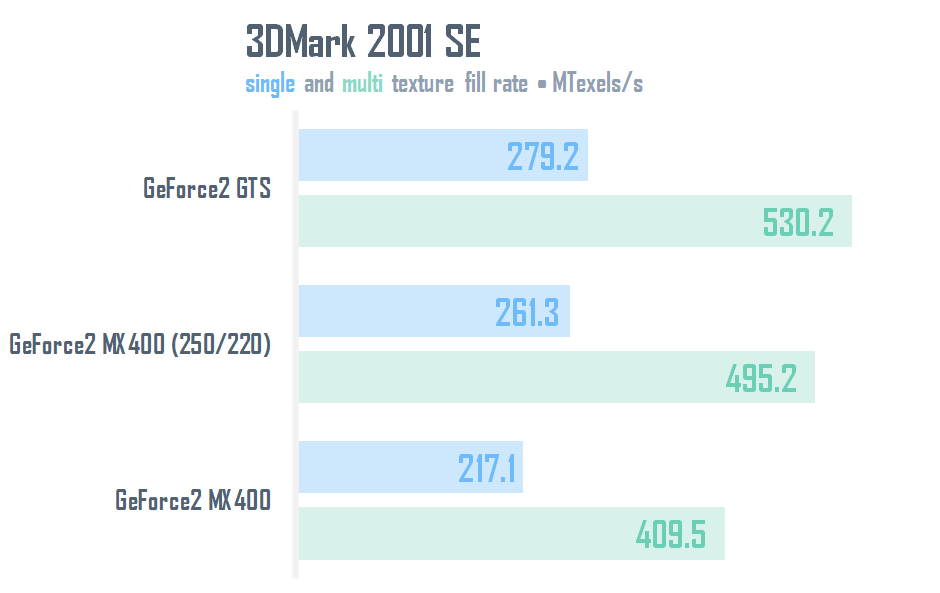
The fill rate test is interesting and a little surprising I’d say, although we had some hints of this by just looking at the general score archived by the overclocked MX400. Basically here the MX400 is almost matching the fill rate of the GTS and the precise explanation of this not so trivial. The GTS has a theoretical texture fill rate of 1’600MTexels/s and 5.312GB/s of memory bandwidth. The (overclocked) MX400 has a theoretical texture fill rate of 1’000MTexels/s and 3.52GB/s of memory bandwidth, so how it’s managing to almost match the GTS has to be researched in both the Celsius internal architecture bottlenecks and the way the 3DMark2001 code is able (or unable) to take advantage of the GTS resources.
Moving to actual games, here we have Quake III Arena, tested with Fast and High Quality presets with the demo001 demo.

With 1024x768 resolution and Fast preset the the overclocked MX400 is 38% behind the GTS, closing the gap to around 31% with High Quality and managing to stay on avarage over 80FPS which is enough to guarantee a very enjojable gameplay.
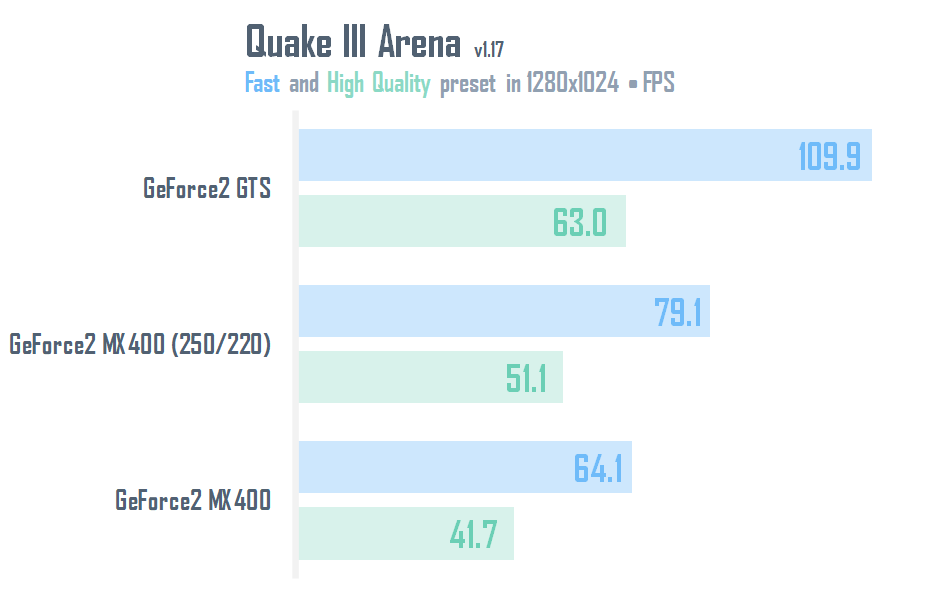
When we move to the higher 1280x1024 resolution the gap narrows again, giving the GTS just a 25% margin over the overclocked MX400 with the High Quality preset.
Unreal Tournament has been tested with the City Intro flyby and give us also the min and max frames per second, other that the avarage.
The quality has been set to “High” both for “World Texture” and “Skin” details.
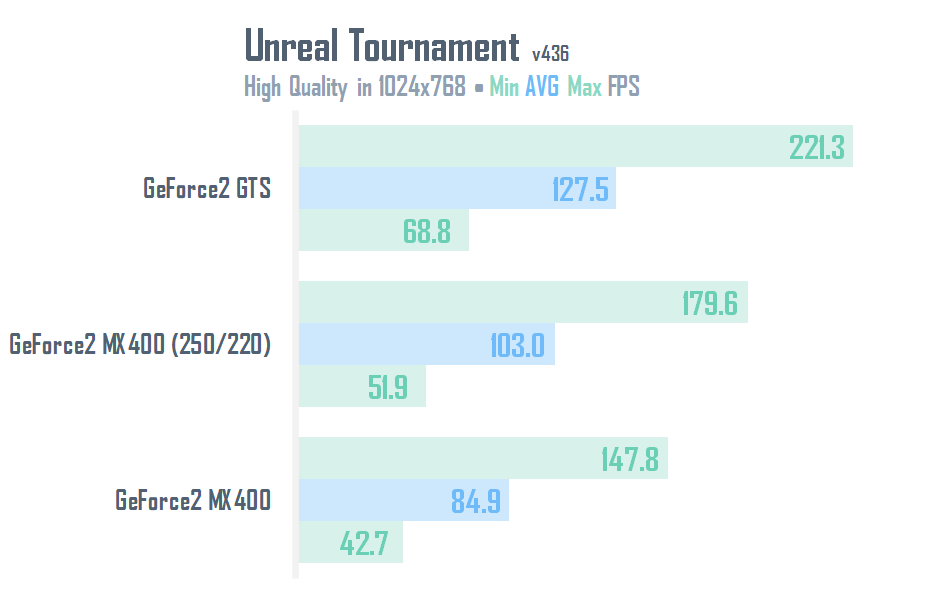
In 1024x768 our overclocked MX400 is pretty close to the GTS, managing to stay just 24% behind it and over 100FPS on avarage, giving a very smooth gaming experience and a good improvement over the stock performance.
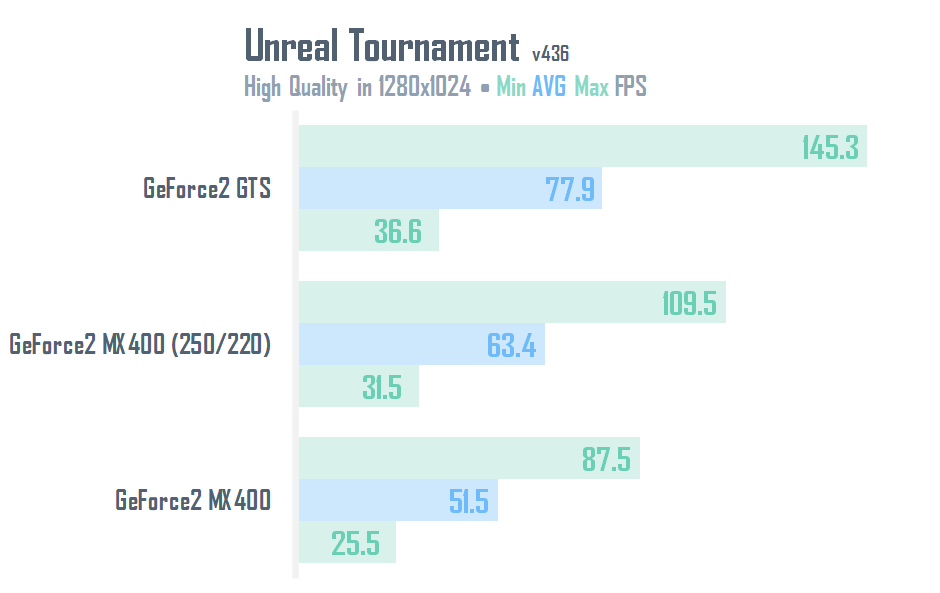
When increasing the resolution the performance difference on avarage is pretty much the same, around 23%.
The low peak is just 17% higher for the GTS which however manages to reach higher peaks by around 33%.
Although the GTS is almost there, both the cards at this detail level are much more suitable for 1024x768 gaming if you want perfectly smooth experience.
The last game I tested is Serious Sam: The First Encounter. This game has a huge amount of video settings but for this cards I left everything at default with the “Normal” preset. This also makes thing much easier if you want run the benchmark on your system and compare the results with mine.
The demo I used to measure the performance is Karnak Peaceful Night. Other than avarage, min and max framerate, Serious Sam gives us also min and max sustained values which can be useful in some case but for this test I used the min/max peaks.
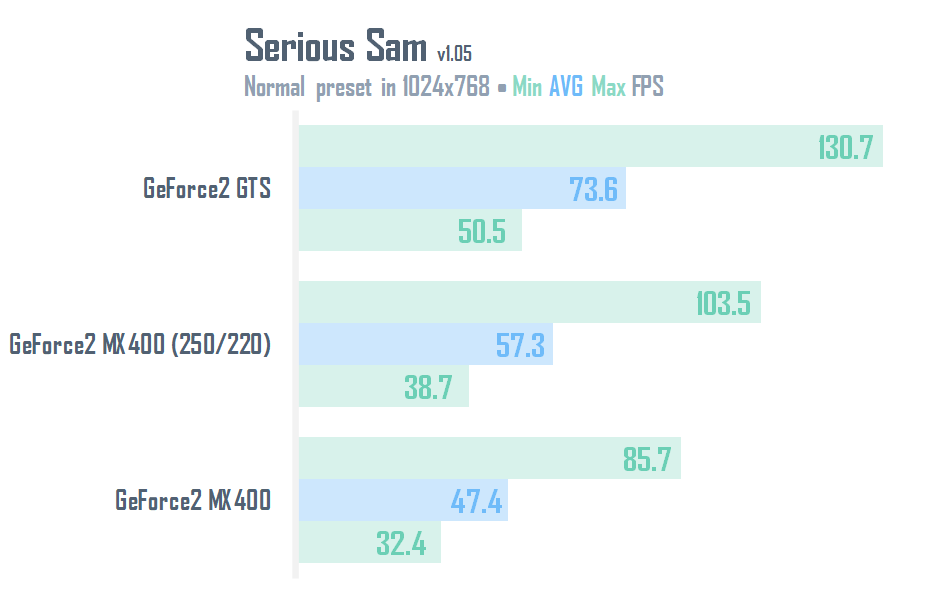
At 1024x768 the MX400, despite the overclock, is still unable to reach the 60FPS mark, giving the GTS almost a 30% advantage in all the situations. Anyway the MX is providing still an overall enjoyable gameplay smoothness, although a little borderline and not much promising for higher resolutions.

As predictable, in 1280x1024 Serious Sam is a little too demanding and the overclocked MX400 is able to reach the 60FPS mark only as a peak and being able to stay just over 30FPS on avarage, with lower peaks in the twenties.
The GTS is not much better, getting just a 15% margin on avarage and providing a pretty similar gameplay experience to the MX400.
Video Comparison
I also recorded the benchmarks and created a video with side-by-side comparison of the GTS and the overclocked MX400.
Except 3DMark 2001 SE, which I run at default 1024x768 resolution and settings, the game benchmarks have been recorded at 1280x1024 resolution.
For the video capure I used an external device to avoid any performance impact on the system.
Conclusions
This has been a very interesting and long awaited compare for me.
Unfortunately the RAM modules on my ASUS V71000/PRO were unable to reach the frequencies I was hoping and this is unfortunate, especially considering that even at 220MHz the card managed to stay just 20-to-30 % below the GTS, which is a great result considering that on paper the GTS is 100% faster and was priced around $200, almost the double of the the MX400 launch price of $129!
It is also incredible think that 20 years ago a $129 video card was able to give very good performance at the most common 1024x768 resolution, which was somehow comparable to 1080p in 2021.
That’s it for this project, hope you enjoyed reading as much as I did running the tests and see you for the next one!
